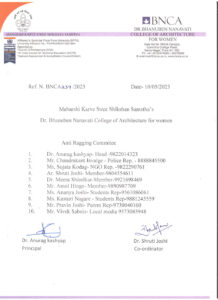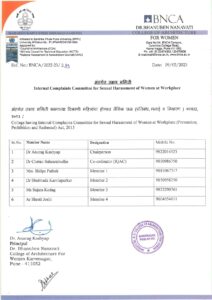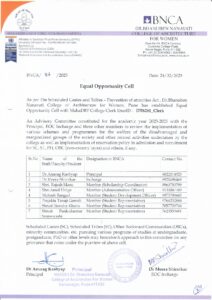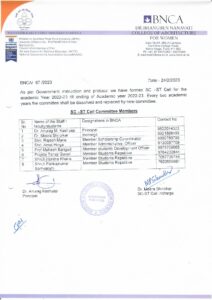- Home
- About Us
- Programs
- FRA-Fee Structure
- Accreditation
- Research
- BNCA Cells
- International Cell
- UNAI
- Universal Design Cell
- Innovation and Incubation Cell
- Archineering Cell
- Environment Cell
- Publication Cell
- IQAC (Internal Quality Assurance Cell)
- BNCA Consultancy Cell ( BCC )
- CEL (Center For Ecological Landscapes)
- Universal Human Values
- SES RE CELL
- Structure Cell
- Center For Cultural Studies
- Teaching+Learning Laboratory
- Career Counselling & Guidance Cell
- Center for Interdisciplinary Studies in Art and Architecture.
- Students
- Infrastructure
- Library
- IT Infrastructure and Computer Labs
- Digital Fabrication Lab
- Wood Working Lab
- Lab for Environmental and Simulation [LEDS]
- Landscape Research Lab
- Material Museum
- Construction Lab
- Survey And Leveling Lab
- Language Lab
- Studios
- Photography Lab
- Clay Studio
- Immerssive Design Lab
- Acoustic Lab
- Board Room
- Auditorium
- Lighting Lab
- Research
- Contact Us
Students Help Desk
The function of the cell is to look into the complaints lodged by any student, and judge its merit. The Grievance cell is also empowered to look into matters of harassment. Anyone with a genuine grievance may approach the department members in person, or in consultation with the officer in-charge Students’ Grievance Cell. In case the person is unwilling to appear in self, grievances may be dropped in writing at the letterbox/ suggestion box of the Grievance Cell at Administrative Block. Grievances may also be sent through e-mail to the in-charge of Students’ Grievance Cell.
Women Grievance Committee
Click Here – Takrar Nivaran Kaksh 2024
Click Here – Grievance Portal
Click Here – BNCA Grievance Policy
Minutes Of Meetings
- Click Here – MOM_GC_Sept-2022
- Click Here – MOM_GC_Nov-2019
Grievance Cell Action Report 2021-2022
- Click Here – Action Report 2021-2022
Objective
The objective of the Grievance Cell is to develop a responsive and accountable attitude among all the stakeholders in order to maintain a harmonious educational atmosphere in the institute.
The Grievance Cell is constituted for the redressal of the problems reported by the Students of the College with the following objectives:
- Encouraging the Students to express their grievances / problems freely and frankly, without any fear of being victimized.
- Upholding the dignity of the College by ensuring strife free atmosphere in the College through promoting cordial Student-Student relationship and Student-teacher relationship etc.
- Suggestion / complaint Box has been installed in front of the Administrative Block in which the Students, who want to remain anonymous, can put in writing their grievances and their suggestions for improving the Academics / Administration in the College.
- Advising Students of the College to respect the right and dignity of one another and show utmost restraint and patience whenever any occasion of rift arises.
- Advising All the Students to refrain from inciting Students against other Students, teachers and College administration
- Advising all staffs to be affectionate to the Students and not behave in a vindictive manner towards any of them for any reason.
- Ragging in any form is strictly prohibited in and outside the institution. Any violation of ragging and disciplinary rules should be urgently brought to the notice of the Principal.
Scope
The cell will deal with Grievances received in writing from the students about any of the following matters
- Academic Matters: Related to timely issue of duplicate Mark-sheets, Transfer Certificates, Conduct Certificates or other examination related matters.
- Financial Matters: Related to dues and payments for various items from library, hostels etc.
- Other Matters: Related to certain misgivings about conditions of sanitation, preparation of food, availability of transport, victimization by teachers etc.
Procedure for lodging complaint
- The students may feel free to put up a grievance in writing/or in the format available in the admin dept. and drop it in boxes
- The Grievance Cell will act upon those cases which have been forwarded along with the necessary documents.
- The Grievance Cell will assure that the grievance has been properly solved in a stipulated time limit provided by the cell.
Execution system
- The cases will be attended promptly on receipt of written grievances from the students within a month
- There will be a grievance cell meeting on the first Tuesday of every month.
- The cell formally will review all cases and will act accordingly as per the Management policy
- The cell will give report in the HOD meeting about the cases attended to and the number of pending cases
Anti-ragging refers to the efforts made to prevent bullying, harassment, and other forms of mistreatment in schools and educational institutions. It is a major issue in India and other countries, and has become a critical part of the education system in recent years. Programs and initiatives aimed at preventing ragging usually involve awareness campaigns, counselling, and disciplinary action for offenders.
The Government of India has floated a site https://www.antiragging.in/ to bring about this awareness. We at BNCA take action towards this awareness by conducting sessions for the girl students making them aware that action will be taken on offenders.
The team members to monitor this is appointed by the Principal. We at BNCA have
- anti-ragging committee appointed.
- poster copies.
- Anti ragging posters put up in admission room for students and parents to be aware of it.
- The position of CCTV cameras is such as to detect any activity happening in different parts of college.
- Students are made to registration and its printout taken.
- Website of anti-ragging cell is informed to students
- 2 meetings conducted in a year and its minutes maintained.
Team members
- Dr Shruti Joshi
- Amol Hinge
- Student representative
- Police representative
- Parent representative
Anti-ragging Committee
Anti Ragging Under taking guidelines Click Here
The purpose of a Divyang cell in a college is to ensure equal opportunities and accessibility for students with disabilities. It also helps in creating a conducive environment for their overall development and encourages their active participation in various academic and extracurricular activities.
The committee shall function from AY 2024-25.
Divyang committee:
| Sr.no | Member type | Designation | Member Name | Phone Nos. |
| 1 | Principal | Chairman | Dr. Anurag Kashyap | 9822014323 |
| 2 | Vice Principal | Chairman | Dr. Sharvey Dhongade | 9850509765 |
| 3 | Student development officer | Member | Ar. Mahesh Bangad | 9975709665 |
| 4 | Teacher representative (female) | Member | Ar. Sayali Andhare | 7769953723 |
| 5 | Teacher representative (female) | Member | Ar. Amruta Barve | 9764002403 |
| 6 | Expert advisor 1 | Member | Mr. Siddhant Shah | 9920765777 |
| 7 | Expert advisor 2 | Member | Ms. Anita Iyer | 9823513415 |
| 8 | Student council representative 1 | Member | Ms. Khushi Parge | 9359913243 |
| 9 | Student council representative 1 | Member | Ar. Sakshi Kulkarni | 9307564406 |
| 10 | Parent representative | Member | Mr. Pankaj Patwardhan | 9921968429 |
| 11 | Parent representative | Member | Mr. Anil Suryawanshi | 9860431997 |
Learning Management System (LMS)
An Open-Source software tool has been deployed by Prof. Umesh Chavan, Head IT at BNCA in 2006.
Introduction: Our college employs a state-of-the-art Learning Management System (LMS) to facilitate seamless and effective online education. The LMS serves as a centralized platform for course delivery, collaboration, and assessment, enabling both students and faculty to engage in dynamic and interactive learning experiences.
Key Features:
- Course Management: The LMS allows instructors to create, organize, and manage course materials efficiently. They can upload lecture notes, presentations, videos, and other resources for easy access by students.
- Communication Tools: Built-in communication tools, such as discussion forums, messaging, and announcements, foster collaboration and interaction among students and instructors. Students can ask questions, participate in discussions, and seek clarification from their peers and instructors.
- Assessment and Grading: The LMS streamlines the assessment process by enabling instructors to create quizzes, assignments, and exams online. It supports various question types and grading scales, facilitating fair and efficient evaluation of student performance.
- Content Creation and Sharing: Instructors can develop interactive and engaging course content using built-in authoring tools or by integrating third-party resources. They can share multimedia-rich content, interactive simulations, and external links to enhance the learning experience.
- Personalized Learning: The LMS supports personalized learning pathways, allowing instructors to tailor course content and activities to meet individual student needs. Adaptive learning features and analytics provide insights into student progress and performance, enabling targeted intervention and support.
Benefits for Students:
- Accessible Course Materials: The LMS provides 24/7 access to course materials, allowing students to review lectures, readings, and assignments at their convenience.
- Engagement and Interaction: Through discussion forums, messaging, and collaborative activities, students can engage with peers and instructors, share ideas, and participate in meaningful learning experiences.
- Flexible Learning Environment: Online quizzes, assignments, and multimedia resources offer flexibility for students to learn at their own pace and accommodate diverse learning styles.
- Feedback and Support: Instant feedback on quizzes and assignments, as well as access to instructor feedback and support, promote continuous improvement and academic success.
Benefits for Faculty:
- Efficient Course Management: The LMS simplifies course administration tasks, such as content creation, organization, and distribution, saving instructors time and effort.
- Enhanced Communication: Seamless communication tools facilitate effective communication with students, enabling timely announcements, feedback, and interaction.
- Data-Driven Instruction: Analytics tools provide valuable insights into student engagement, performance, and learning outcomes, empowering instructors to make data-driven instructional decisions.
- Collaborative Teaching: The LMS supports collaborative teaching efforts by enabling multiple instructors to co-create and co-facilitate courses, fostering interdisciplinary collaboration and innovation.
Getting Started: To access the LMS, students and faculty can log in using their college credentials via the designated portal. Upon login, they will be greeted with a user-friendly interface, where they can navigate to their respective courses, access course materials, participate in discussions, and submit assignments.
Training and Support: The college offers comprehensive training and support resources to help users maximize the benefits of the LMS. This includes online tutorials, workshops, user guides, and dedicated helpdesk support to address any technical or instructional inquiries.
Technical Requirements: To ensure optimal performance, the LMS is compatible with commonly used web browsers (e.g., Chrome, Firefox, Safari) and operating systems (e.g., Windows, macOS, iOS, Android). Users are encouraged to keep their browsers and devices up to date for the best experience.
Policies and Guidelines: Users are expected to adhere to the college’s policies and guidelines governing the use of the LMS. This includes respecting intellectual property rights, maintaining academic integrity, and adhering to acceptable use policies.
Contact Information: For technical assistance or inquiries related to the LMS, users can contact the college’s IT helpdesk.
Attendance Tracking: One of the standout features of our college’s Learning Management System (LMS) is its robust attendance tracking functionality. This feature enables instructors to efficiently monitor and record student attendance for both in-person and online classes.
Key Features:
- Flexible Attendance Management: The LMS offers flexibility in attendance management, allowing instructors to customize attendance parameters based on their preferences and course requirements. They can set attendance policies, define attendance criteria (e.g., presence, participation), and configure attendance tracking settings to align with their teaching objectives.
- Multiple Attendance Recording Options: Instructors can choose from various attendance recording options to suit different instructional modalities. For in-person classes, they can take attendance manually or use integrated barcode or QR code scanning capabilities for quick and accurate attendance tracking. For online classes, attendance can be recorded based on student participation in synchronous sessions, completion of assigned tasks, or other engagement metrics.
- Real-Time Attendance Reporting: The LMS provides real-time attendance reporting and analytics, giving instructors instant visibility into student attendance patterns, trends, and exceptions. They can generate attendance reports, view attendance statistics, and monitor student attendance status throughout the course term.
- Automated Attendance Notifications: To streamline attendance management, the LMS can send automated notifications to students regarding their attendance status. Students may receive alerts for missed sessions, upcoming attendance requirements, or other attendance-related updates, helping them stay informed and accountable.
- Integration with Grading System: Attendance data captured within the LMS seamlessly integrates with the grading system, enabling instructors to factor attendance into overall course assessment and grading. They can incorporate attendance records into grade calculations, attendance-based assignments, or participation scores, ensuring that attendance contributes to student success and accountability.
Benefits:
- Efficient Attendance Tracking: The LMS simplifies attendance tracking processes, reducing administrative burden and paperwork for instructors. Automated attendance recording and reporting streamline workflows, allowing instructors to focus more on teaching and student engagement.
- Accurate Attendance Records: With barcode or QR code scanning capabilities and real-time attendance reporting, the LMS ensures accurate and reliable attendance records. Instructors can easily identify attendance discrepancies, address attendance-related issues proactively, and maintain accurate records for compliance and reporting purposes.
- Enhanced Student Engagement: By actively monitoring attendance and participation, instructors can identify students who may need additional support or intervention. Timely feedback and support can foster greater student engagement, retention, and success in the course.
- Data-Informed Decision Making: Attendance data and analytics provided by the LMS enable instructors to make data-informed instructional decisions. They can identify attendance trends, assess the impact of attendance on student performance, and implement targeted interventions to support student success.
Assignment Submission and Grading: Our college’s Learning Management System (LMS) offers a comprehensive assignment submission and grading feature, empowering instructors and students with a seamless and efficient workflow for assignment management and assessment.
Key Features:
- Assignment Creation: Instructors can create and distribute assignments directly within the LMS, specifying instructions, due dates, submission requirements, and grading criteria. They can customize assignment settings based on their preferences and course objectives, including individual or group assignments, file upload options, and submission formats.
- Online Submission: Students can submit their assignments electronically through the LMS, uploading soft copies of their work directly to the designated assignment submission areas. The LMS supports various file formats, allowing students to submit documents, presentations, multimedia files, and other digital artifacts relevant to the assignment.
- Submission Tracking: The LMS provides instructors with real-time visibility into assignment submissions, allowing them to monitor submission status, track deadlines, and identify late submissions or non-compliance. Automated notifications and reminders can be configured to alert students and instructors of upcoming deadlines and submission updates.
- Grading and Feedback: Upon submission, assignments are accessible to instructors for grading and feedback purposes. The LMS offers intuitive grading interfaces where instructors can review student submissions, provide feedback comments, and assign grades or scores directly on the screen. Grading rubrics, annotation tools, and inline commenting features facilitate detailed and constructive feedback.
- Gradebook Integration: Graded assignments seamlessly integrate with the LMS gradebook, where instructors can view and manage student grades, track progress, and calculate overall course grades. Grades are automatically recorded and updated in the gradebook, providing students with transparent and up-to-date feedback on their performance.
- Plagiarism Detection: To uphold academic integrity, the LMS may incorporate plagiarism detection tools that analyze assignment submissions for originality and flag potential instances of plagiarism. Instructors can review plagiarism reports and take appropriate actions to address academic misconduct.
Benefits:
- Streamlined Assignment Management: The LMS streamlines assignment creation, distribution, and submission processes, eliminating the need for manual paperwork and administrative overhead. Instructors can manage assignments efficiently within the digital environment, saving time and resources.
- Enhanced Feedback and Assessment: Interactive grading interfaces and feedback tools empower instructors to provide timely, personalized, and actionable feedback to students. Students receive constructive feedback directly within the LMS, fostering continuous improvement and learning.
- Transparent and Fair Evaluation: Transparent grading criteria and rubrics ensure consistency and fairness in assessment practices. Students have clear expectations regarding assignment requirements and grading standards, promoting accountability and academic integrity.
- Data-Driven Insights: Assignment data and analytics available through the LMS enable instructors to gain insights into student performance, identify learning gaps, and assess the effectiveness of instructional strategies. Data-driven insights inform instructional decision-making and support student success initiatives.
In addition to its robust assignment submission and grading features, our college’s Learning Management System (LMS) also includes comprehensive feedback and survey tools designed to gather valuable insights from students, faculty, and other stakeholders. These tools play a crucial role in continuously improving our educational methodologies and infrastructure facilities to better serve the needs of our students.
Key Features:
- Customizable Surveys: The LMS offers customizable survey creation tools that enable administrators, faculty members, and student representatives to design surveys tailored to specific topics, such as course content, teaching methodologies, campus facilities, and student support services.
- Automated Distribution: Surveys can be distributed electronically through the LMS to targeted groups of participants, including students enrolled in specific courses, faculty members teaching particular subjects, or the entire college community. Automated distribution features streamline the process of reaching out to participants and collecting feedback.
- Anonymous Responses: To encourage honest and candid feedback, survey participants have the option to submit responses anonymously. This anonymity fosters open communication and ensures that respondents feel comfortable sharing their opinions and suggestions without fear of repercussion.
- Multi-Question Formats: The survey tools support a variety of question formats, including multiple-choice, Likert scale, open-ended, and ranking questions. This versatility allows survey creators to gather quantitative and qualitative data, providing a comprehensive understanding of participant perspectives.
- Real-Time Reporting: Survey responses are aggregated and presented in real-time through intuitive reporting dashboards within the LMS. Administrators and stakeholders can access visualizations, charts, and summary statistics to quickly analyze survey results and identify key insights and trends.
- Actionable Insights: Survey data collected through the LMS serves as a valuable source of actionable insights for decision-making and improvement initiatives. Administrators and faculty members can use survey findings to identify areas of strength and opportunities for enhancement across various aspects of the college experience.
Benefits:
- Continuous Improvement: The feedback and survey tools foster a culture of continuous improvement by providing stakeholders with a platform to voice their opinions, share feedback, and contribute to ongoing efforts to enhance educational methodologies and infrastructure facilities.
- Student-Centric Approach: By soliciting feedback directly from students, faculty members gain valuable insights into student preferences, needs, and challenges. This student-centric approach ensures that improvements are aligned with the interests and priorities of the student body.
- Informed Decision-Making: Survey data collected through the LMS enables administrators and decision-makers to make informed decisions regarding resource allocation, policy changes, and strategic initiatives. Evidence-based decision-making ensures that initiatives are grounded in data and responsive to stakeholder needs.
- Engagement and Accountability: Engaging students and faculty in the feedback process fosters a sense of ownership and accountability within the college community. Participants feel empowered to contribute to positive change and take pride in being active participants in the improvement process.
By leveraging the feedback and survey tools available in the LMS, our college demonstrates a commitment to excellence in education and a dedication to meeting the evolving needs of our students and faculty.







